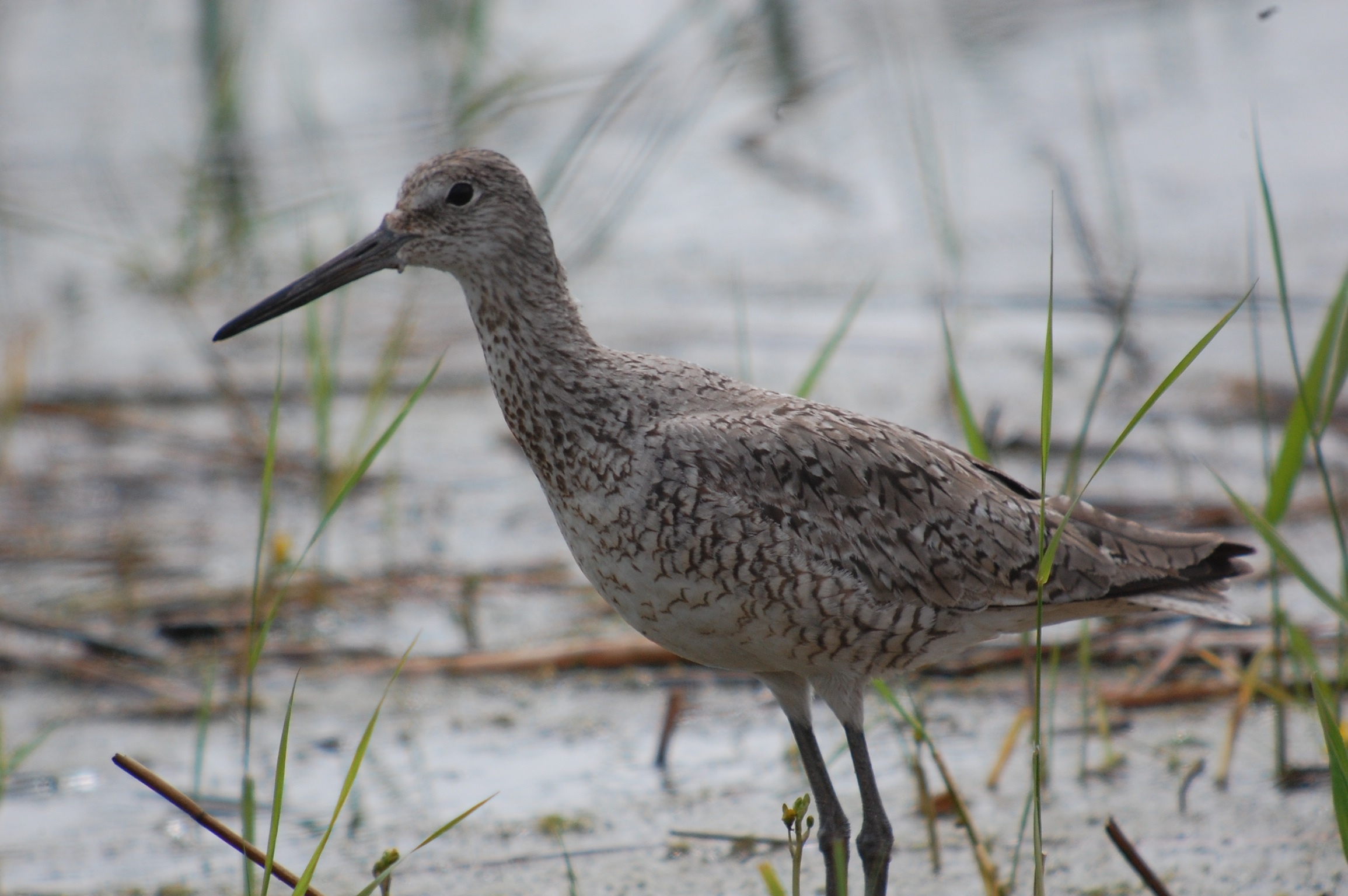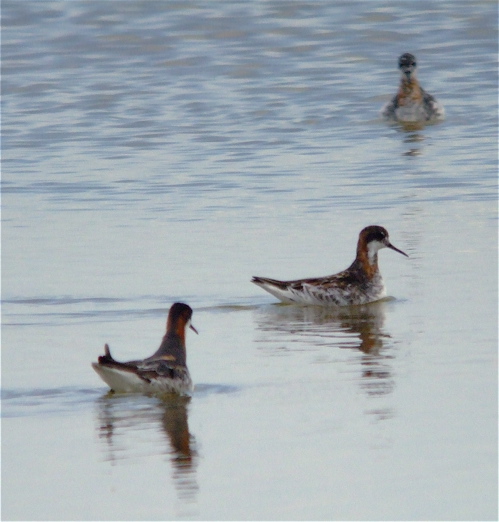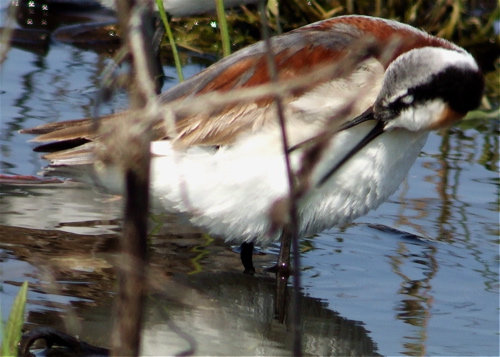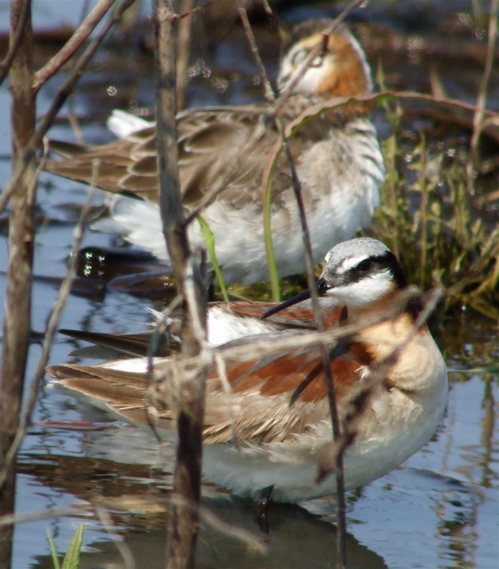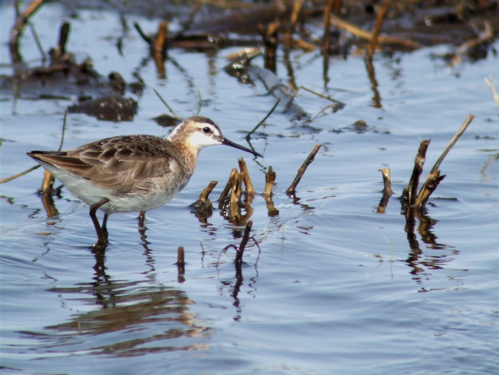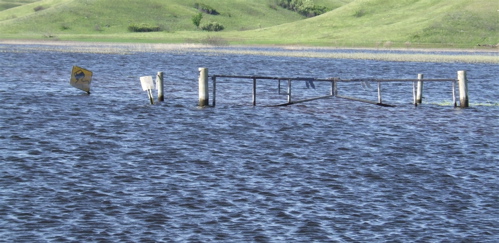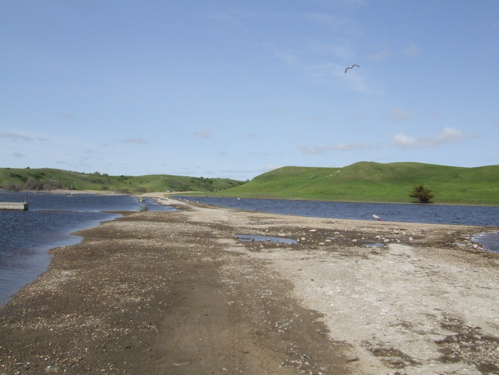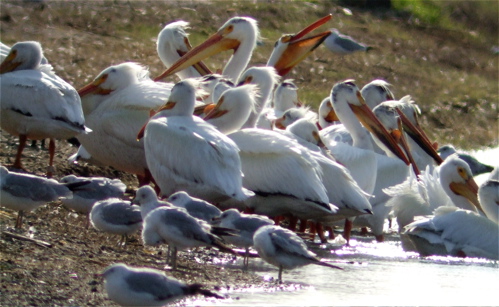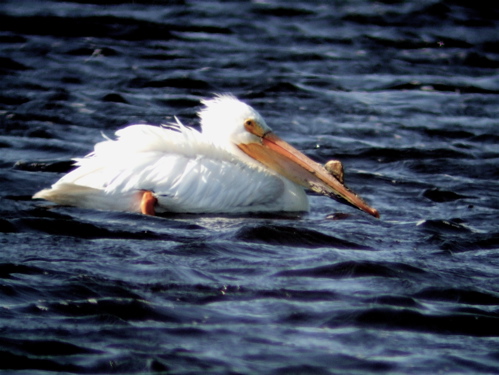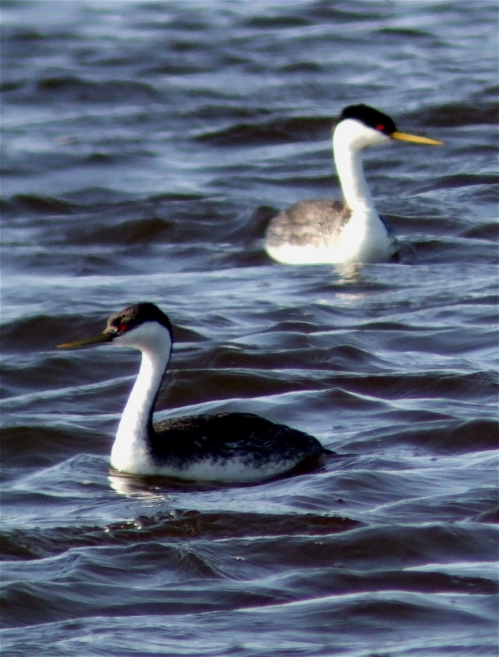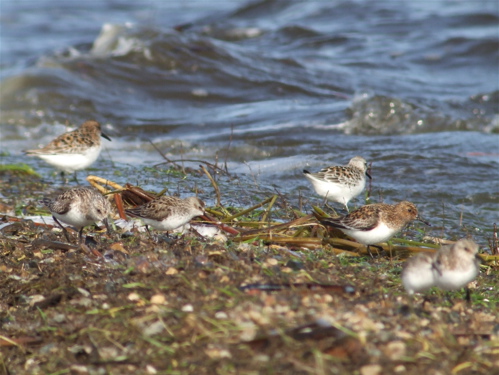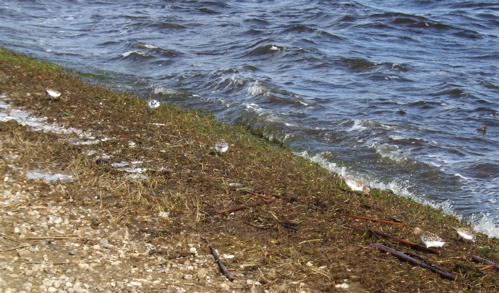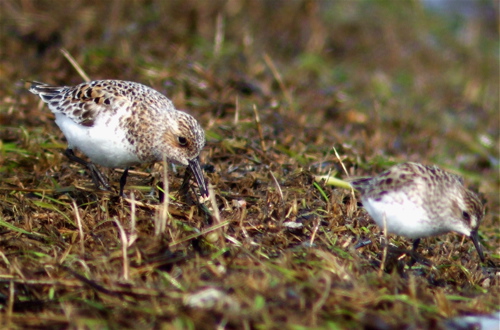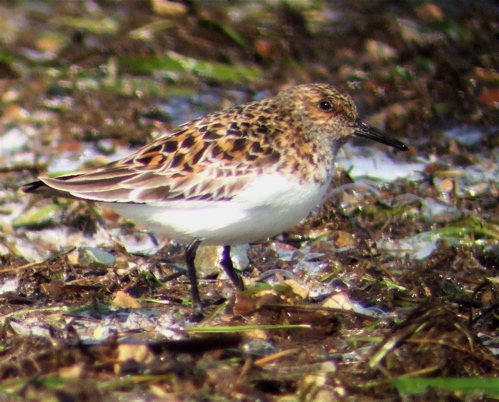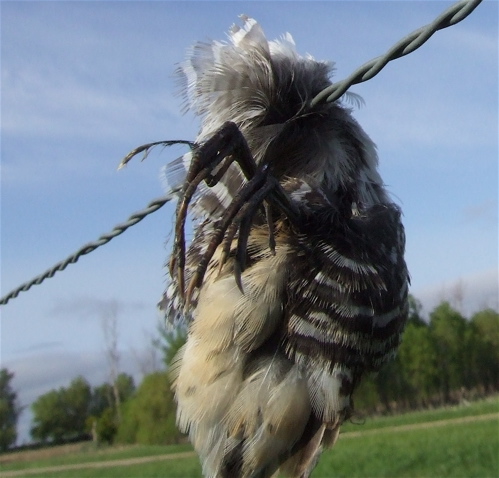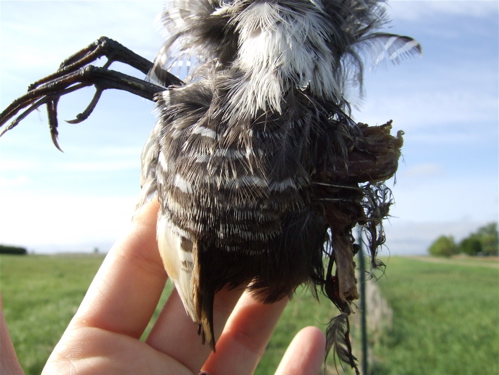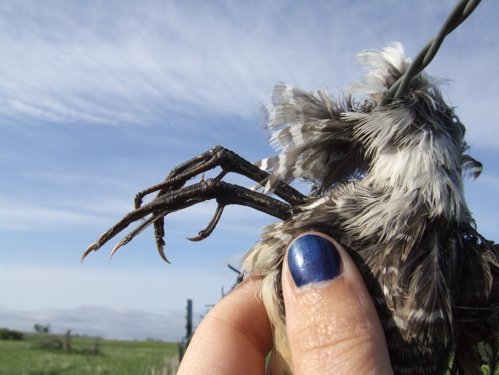Birdchick Podcast #73: Where Can A Birder Go
Two VERY interesting articles on my list this week. One from the American Birding Association's publication called Winging It. Go to the Winging It page and click on Vol 23, no. 5 and look for Birding With A Conscience. Also, check out this article on Birding While Black--Does It Really Matter? He was part of the Focus on Diversity birding conference. You can watch some of the speakers here.
Fidelity Exploration & Production Co., of Denver agreed to plead guilty and pay a $1,500 fine for killing a solitary sandpiper that was found in a waste pit during drilling operations in western North Dakota.
When I was in North Dakota this past June with fellow bird bloggers we saw the above oiled duck (I think it's an oiled pintail). I'm now wondering if was oiled in similar circumstances and wish we'd documented it better. It was far away on private property and mobile enough to get away from us. There was no safe way to retrieve it, but wish I documented it better.
Human encroachment on the Tundra (like oil refineries) are creating an imbalance in the predator/prey balance.
From Nature Canada, Birds at Risk: The Importance of Canada’s Boreal Wetlands and Waterways: "The North American boreal forest supports more than 50 percent of the global populations of 96 bird species, including landbirds, shorebirds, and waterbirds.10 The boreal is critical to the majority of iconic species such as the Common Loon, Whooping Crane, Canada Warbler, and White-throated Sparrow."
And if you don't understand why the tar sands are a bad idea, take a look at this before and after photo of what happens to the area when they go in for the oil. This is terrible land stewardship, short-sighted and a terrible option.
And now a really cleansing link:
Some Phalarope Fun
I found some phalarope photos that I had forgotten about. These are some red-necked phalaropes that we saw on the Steppes in Kazakhstan. When you are learning shorebirds, phalaropes are ones that can be easy to distinguish from the others, they have a unique shape, can be quite colorful and they are just plain fun to watch. They spin around in the water kicking up sediment and food below. No matter what country you are in, you can spot that spinning characteristic easily if they are around.
Plus, phalaropes are so pretty, look at that burgundy highlighted with delicate gray and white, touched off with some black. Above is a Wilson's phalarope seen in a pothole just outside of Arrowwood NWR in North Dakota during the Potholes and Prairie Bird Festival. That's a great thing about North Dakota, just driving to your destination will reveal great birds. We couldn't get into the NWR because of the flooding, so we just drove around it and in the puddles were birds. I was with my friend Katie and she would pull the van over while I sat in the back, opened the side door and digiscoped the phalaropes. Birds tend to not mind vehicles, just what comes out of a vehicle.
Here's a pair of Wilson's phalaropes preening. If you are not familiar with phalaropes, you might think that is the male in the front of the pair. It's not, that's the female.
In phalarope world, you have a great term to use that you can impress your friends with at parties: reverse sexual dimorphism. The females are more colorful and they pursue the males. They defend a territory and once they have attracted a male and mated, she lays the eggs and heads south to get a head start on migration while the males stays behind to incubate the eggs and raise the young.
Here's a shot of just the male, he is not colorful since he's going to be the one sitting in one spot to incubate the eggs. It's interesting that the female doesn't partake of any of the chick rearing duties. She doesn't bring food to the male while he incubates, she doesn't give him a break, nothing. It's wham, bam, thank you ma'am, she lays the eggs and then says, "See ya!"
I wonder if female phalaropes ever get guilt for putting their migration before their offspring?
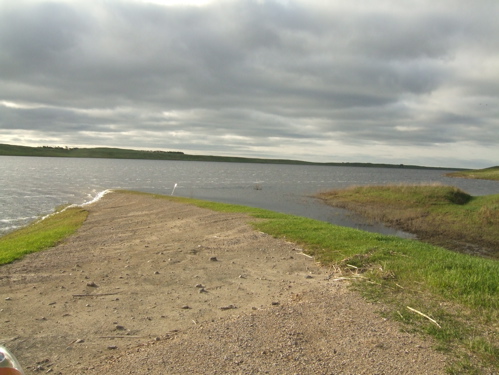 I spent the day birding around Arrowwood NWR while in North Dakota with my buddy Kate Fitzmeier. And when I say "around," I literally mean around--it was completely flooded, note the the flooded road above.
I spent the day birding around Arrowwood NWR while in North Dakota with my buddy Kate Fitzmeier. And when I say "around," I literally mean around--it was completely flooded, note the the flooded road above.
Some roads were more flooded than others. Check out the Slippery When Wet sign above--I'll say! I was sad we couldn't take this road, last year it led to the refuge's bison heard. I was also sad for the refuge itself, just about every building experienced severe flooding.
Though many roads were closed, some like this road did make for a nice path for birding. Kate stayed with the vehicle, she was on a mission for some badger. We found some holes in the hills that looked very badger-worthy.
When we arrived, some pelicans and gulls were loafing on the road. You might notice that some of the pelicans have little horns on the top of their beaks. They get those during mating season and then after they mate, it comes off (So does that growth on the bill signify that they are horny?--insert bad joke grown here). When I've been out to pelican rookeries for banding, we could sometimes find horns on ground that had been shed...they looked like old nasty toe nails. As I walked down the road, the pelicans assessed my movement, "Is she really coming this way? Do we really need to move?'
Once out on the water, I felt as though I was getting disdainful looks, I had disturbed their valuable loafing time.
There were quite a few western grebes out on the water. Some were at the very beginnings of their courtship ritual. We didn't see any actual dancing, but there was some head bobbing and pre-dancing stops going on.
Quite a few shorebirds were running around. We saw a ruddy turnstone (not pictured above) and then several of the above peeps who didn't seem to care about people one bit. I was confused by one of them and had to enlist the help of South Dakota shorebird guru Doug Buri. I've gone on one of his shorebird workshops which are great and I highly recommend him, one year I need to do his sparrow workshops. He told me long ago when I lamented about shorebird id that my problem was that I looked at shorebirds from too far away, when you have them close, it's easier to identify them and it certainly is true that it's easier to get an id if they are close.
This day, my challenge was that the peeps kept running towards me as I was trying to take a photo. I kept having to back up to be able to focus them in the scope because the kept running towards me. I took the above photo without the scope, at one point the sanderings were barely six feet from me. I left my shorebird guide at home and was not having much luck deciding on an id of the larger peeps with internet searches, so I emailed Doug some photos.
Fortunately, I was able to get some size comparison shots. The smaller peep on the right was so tiny, I was convinced it was a least sandpiper, but then noticed that the bill and the feet were the same color...that can't be a least sandpiper. Doug confirmed it when I sent him the photo that it was a semi-palmated sandpiper. Now, what could the larger bird on the left be?
The larger peep ended up being a sanderling and I needed Doug's help to figure that out. He said the reason was that I was probably not used to seeing them in variable breeding plumage, but I think my confusion was habitat. When I see sanderlings on the coast, they are fairly easy to id since they constantly run back and forth with the surf. Not so much surf on the North Dakota prairie. There is another way to tell them apart rom other shorebirds--they don't have a back toe, but trying to see that when they are darting around in grass, it a bit hard to see.
A Piece Of Rail
Warning! The photos in this post might be gross for some for some readers. It's about a piece of bird (most likely a rail) that I found on a barb wire fence. One of the things that really surprised me about this year's Potholes and Prairie Bird Festival was the amount of flooding that occurred around Jamestown and is still causing trouble for the area. All we heard in the news was about the Fargo flooding but there was still much more flooding going on in central North Dakota. It's all the more impressive to me that organizers were able to get the festival going this year despite the flooding making lodging difficult (not to mention what the flooding did to the organizers' personal residences) and the economy causing more people to tighten their belts in regards to travel.
But the flooding made for some great birding. For example, American bitterns were seen all over by many festival participants. Zeiss rep Steve Ingraham got some fun video of an attempted mating ritual between two bitterns (check out the males white shoulder patch action going on).
I went out with my buddy Katie for some birding and I noticed some fluff on a barb wire fence. We pulled over and walked/hopped over the water filled ditch to get a closer look to see what it was. It was a piece of bird.
I tried to pull it off to get a bitter look, but it was really hooked into the barb. The general shape and size read "rail" to me. I wondered what happened. There was a marsh across the road, had the rail flown across and hit the top line and got stuck and died? Then perhaps some predator or scavenger came by and ate part of the bird? Barb wires can kill low flying birds as I learned at the Leks, Treks and More festival when we did the marking for the lesser prairie chickens.
The feet, the tail tip, the brown striping, and the state the bird piece was found in have narrowed it down for me to either Virginia rail or sora. However, I just can't decide on which.
At first, I thought I had it figured out with the feet, I know that sora's have green toes and what was left of this bird had black toes. However, if you check Virginia rail toes, those are pink. The decomposition could have caused the toes to turn black.
I tried to see if I could find any images of rail vents to see if that would help my id, but could not. This one may have end with "back half of rail."
Random Links
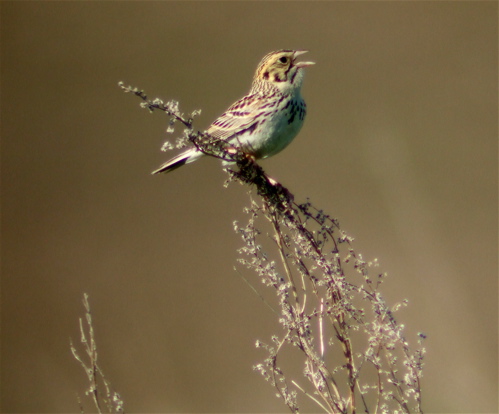 I'm currently in North Dakota at the Potholes and Prairie Bird Festival giving workshops and leading trips. Today was awesome, I did what I would call a slow and easy trip. It's intent is to be a digiscoping workshop, give people a chance to try and take some photo of birds without feeling rushed like you do on regular field trips, but it was just such a joy to have a chance to sit and spend an hour with a great bird like a Baird's sparrow (above), really get to know this elusive sparrow.
I'm currently in North Dakota at the Potholes and Prairie Bird Festival giving workshops and leading trips. Today was awesome, I did what I would call a slow and easy trip. It's intent is to be a digiscoping workshop, give people a chance to try and take some photo of birds without feeling rushed like you do on regular field trips, but it was just such a joy to have a chance to sit and spend an hour with a great bird like a Baird's sparrow (above), really get to know this elusive sparrow.
And yes, my darling husband who is reading this from home, that bird is different from all the sparrows you see at the feeder.
Also, on Twitter today, someone was passing around to a link to a disturbing set of photos. A bull frog eating a Eurasian tree sparrow. If you would like to see the disturbing set, click here. If you would like to avoid that image being burned into your brain, focus on the happy Baird's sparrow above.
Brown Birds At Potholes & Prairie Bird Festival.
This past Sunday was just about as perfect as a day can get for me. It started at 4:15am when Kate and I woke up to load up our van for the ride home at the end of the festival. At 5am, we met up with good friends Kim Risen and Bill of the Birds to have some time to just sit and enjoy some Sprague's pipits and Baird's sparrows. It was rounded out with some fun driving time with my buddy Kate and then finished with a spicy Thai meal and some quality time with Non Birding Bill.
One of the first birds we saw in the wee hours of the dawn--a short-eared owl! And check it out, it's tiny, barely there tufties were erect. Not only did we see the owl...we got to see what it's named for. Take that, historic ornithologists who gave birds names for obscure parts barely seen in the field!
We stopped on some private ranch property (that allows birders to enjoy the sparrows) and headed out. You could hear the cows in the distance and one of our first birds was--
A chestnut-collared longspur just chillin' on the fence. There are brown birds, and then there are Brown Birds. Chestnut-collards take brown to a whole new beautiful level and they still have that bobolink thing going with their black chest. BNA describes them as prairie specialists: "Typical breeding habitat is arid, short to mixed grass prairie that has been recently grazed or mowed...this species avoids nesting in areas protected from grazing, instead preferring pastures and mowed areas such as airstrips, as well as grazed native prairie habitats."
The next bird we heard was a grasshopper sparrow (that's the hunch backed looking bird in the above photo). It's buzzy call was mixed with western meadowlark and about that time we heard Sprague's pipits overhead. I've linked to the songs, but if you have birdJam or any bird cds and are not familiar with these songs--look them up.
It wasn't long after that before we heard the sweet sound of the Baird's sparrow. And I had a video earlier, but here the lovely song of the Baird's sparrow yet again:
You can hear Canada geese and western meadowlarks singing in the background of that video.
There was also a pair of savannah sparrows nearby--above is one of them. The two would chase each other and periodically, the Baird's would get caught up in the chase as well. I don't think Baird's feel that threatened by savannah sparrows, but I have a feeling that their fighting was taking place a little too close to its nest.
The Baird's sparrow kept getting closer and close. Kim suggested that we all get as low to the ground as we could and see how close the Baird's would get to us. It came within ten feet. Here are the photos, it was almost too close to fit into the field of view of my scope.
There we were listening to one of the sweetest bird songs in North America, and even more sweet songs overhead and surrounding us--it seemed amost unreal to hear the Sprague's pipit's descending song right after the Baird's. The prairie was chilly, but gradually warming in the glow of sunrise, giving the wet ground a sweet and musky smell. You could barely hear traffic. Sharing the moment with people who truly appreciate the moment and prairie in the same way is what really made the morning, this is what birding is truly all about for me. As we were enjoying moment on the prairie with the Baird's we heard two vans pull up way back by the roadside where we parked. A quick scan in the scopes revealed the vans were full of people with floppy hats and khaki hats: birders. They unloaded.
Kim Risen and I recognized one of the people as fellow Minnesota birder and Victor Emanuel tour leader Kim Eckert. I always get a kick out of the random meetings that can happen in another state. He was leading two vans for VENT and like us was there for the Baird's and the Sprague's pipits. We went over to say hello.
And as much as I would have liked to have sunk into the ground and just enjoy the sounds and smells for the rest of the day (despite the ticks) we had to head home. So, once again, after a cold, crappy, rainy, windy reception to the state, all is once again forgiven with a North Dakota dawn.
Friends And Bloggers At Potholes And Prairie Bird Festival
Ah, marbled godwits in the sun! Since the first two days of the festival were windy and rainy and generally not all that fun to bird in, I was worried people would go away with a wet feeling about the festival.
Prairie birding really is something everyone should experience at least once, but when it's windy and rainy, it's not so much fun. But on the sunny days, it's magical. Fortunately, the sun came out Friday, late afternoon, all day Saturday, and Sunday so people got to experience the gloriousness of North Dakota.
This was one of the many orchard orioles we saw in North Dakota. I carpooled to the Potholes and Prairie Bird Festival with my friend Kate Fitzmeier who works for Eagle Optics. I've said it before and I'll say it again: when you work bird festivals, you see the same vendors again and again, and it becomes this kind of strange nomadic birding family. I went to the festival working a Swarovski table so it worked out well to share expenses with Kate. One of the things I love about Kate besides her sense of humor is that she works hard, she birds hard...
...and when she sees a giant coot sculpture on the side of the road, she knows it's a perfect photo opportunity! There were so many friends at this festival and so many bird bloggers: Rondeau Ric, Somewhere in NJ, Nature Knitter, Bill of the Birds, Julie Zickefoose, and Birding Couple!
This was one of the many American avocets we saw on the prairie. I was excited to meet Birding Couple, it's one of the many blogs I enjoy reading when I have the time. I talked to them for a few minutes at one of the mixers and said that I would love to have dinner with them the next night...but stupidly did not exchange phone numbers. When Kate and I had a free couple of hours the next day, we heard a report of three whooping cranes nearby and set out to find them, completely missing the dinner hour. I worried about missing a meet up with the Birding Couple but figured one: they are birders, they would understand the need to chase a whooping crane report and 2. I still had another day of festival in which to hang out with them. We didn't get the whooping cranes and then it turned out that the Birding Couple ended up leaving early the following morning. I sent them a quick email that I was sorry to have missed them...although leaving out that I ditched them for whooping cranes. They sent an email back also expressing regret saying that they weren't around that afternoon because...they went looking for whooping cranes! Ah birders!
These are some sharp-tailed grouse that were lekking on the prairie. Behind the grouse, the coteau (or high point) almost looks like a tiny mountain range, but that's how cool a hill can look on the prairie. Speaking of lekking and arguing birds, I found myself the middle man between Zickefoose and Non Birding Bill. My husband wanted me to tell Julie that he loves her posts on saving "Mother Earth" but demanded a Chet Baker post. Julie told me to tell NBB that she would as soon as she got a carbon copy of his letter to his congressman regarding his outrage over mountaintop removal mining. NBB then sent back a witty quip about "who still uses carbon copies" and well, it just went downhill from there. Fortunately, Julie has finally posted a Baker post and my husband's addiction to the cutest and smartest Boston Terrier this side of the Internet is appeased...for the moment.
The Rainy Part of the Potholes and Prairie Bird Festival
First off: I have spent the morning updating my appearances on my Google Calendar page (all the way into March 2009) and have even included the next Birds and Beers on June 19 at Merlin's Rest. Birds and Beers is an informal gathering of birders of all abilities to connect and share birding stories and info. If you are remotely interested in birds, you're invited.
I love, love, love birding in North Dakota and love the Potholes and Prairie Bird Festival. But, every year there is always a day of cold rain and harsh winds that make even the most fervent bird enthusiast wonder, "What the heck am I doing with my life?"
But then you get the clear, crisp mornings at dawn on the prairie and all is forgiven and you realize that as a birder, this is what you live for. I'll blog that later, now it's time for the crap weather birding. One morning, I woke up at 4:15 am to the sound of heavy rain. I had to get ready for my 5am bus to Chase Lake NWR, so piled on the layers and rain coat and headed to the hotel lobby. It was silent, but when I turned the corner, I found this:
Field trip participants gathered round a muted tv desperately watching the weather channel and hoping against hope that the 90% chance of all day rain and strong winds predicted the night before was really going to stop at 5:05am. I laughed at the silence and intensity of the scene. Mental Note: Don't laugh at birders before 5am and before they have had a serious cup of coffee.
Alas, it rained for most of the day. At some points it was an "honest rain" as someone referred to it, others it was accompanied by unforgiving winds. And yet, at other times, it would stop while we were on the bus, and suddenly begin a light drizzle as soon as people started getting off the bus. Doh! I traveled to Potholes and Prairies with my friend Kate from Eagle Optics and we chose to sit in the back of the bus to not only help point out birds for people in back, but to try and provide some comic relief. I was so glad to not be an official field trip leader for this trip since that would mean getting off the bus at every stop to find the target. Bless poor, wet guides Kim Risen and Stacey Adolf-Whipp for doing that hard task. The big upside for Kate and I was that we got to hang with Rondeau Ric (although sans stache, but apparently it was not the source of his comic power, so he was still funny).
One morning, Kate and I had a couple of hours and we checked out Arrowwood National Wildlife Refuge on our own. We were excited to see the bison on the refuge. I love the above sign warning about what you should do around the bison that can roam on the road. Helpful things like "Do No Disturb or Chase" or "Tails Up! A Raised Tail is a Warning Sign to Stay Away!" You may think the sign is overkill, but after the dork wad I encountered at Antelope Island a couple of years ago in Utah, I'm not so sure.
We found the small herd on a hillside far enough away that we could safely digiscope them.
The baby bison were a trip. Some were frolicking, some were nursing. We saw no "tails up" unless you count the bison that were...evacuating their backside. However, our buddy, the Zeiss Rep, Steve Ingraham had a much closer encounter with the bison than we did--they completely blocked the road once he drove into their paddock. He made it out okay without any headbutting dents to his his rental, but I'm glad it was him and not us.
Speaking of Zeiss, I have to give them some props for their freebie at their booth--gummy binoculars--genius! Not quite as genius as the bag 'o gin from Bird Uganda Tours given away in Texas, but a mighty close second. They did taste really good. Especially the red ones.
One of the coolest things Kate and I found at Arrowwood was a large flock of cliff swallows swarming around a bridge. I'm sure they were nesting beneath it. This flock was already swirling over our heads. Then, for some reason, I bent down on the side of the bridge to see if I could see any of the nests and they skies doubled with more birds fleeing the nests on the bridge. It was pretty cool! We left soon after that in case any of the birds needed to get back to incubating or brooding chicks on this cool day. I did get a video to try and capture the experience:

